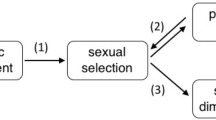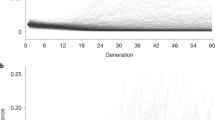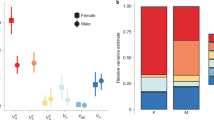Abstract
The ubiquity of sex in the face of what is called the 'cost of meiosis' represents one of the major paradoxes of evolutionary biology1–3. Theoretical work has shown that sexual females can only be maintained in mixed populations of sexual and asexual females if their offspring are of the order of twice as fit as those of asexual females1–8. Previous experiments using the grass Anthoxanthum odoratum have shown substantial fitness advantages for genetically variable arrays of individuals relative to genetically uniform arrays planted in particular experimental designs9–12. Yet, in natural conditions progeny do not become arranged at set spacings in arbitrary places within a population, but are dispersed around parents to form a 'seed shadow' with decreasing density away from source13. We report here the results of an experiment designed to simulate the natural dispersal pattern of progeny around parents when these progeny are either genetically uniform and identical to parent, or sexually-produced by those parents and genetically variable. Our data show that sexually generated progeny of Anthoxanthum odoratum have reproductive rates, summed over two years, that are 1.43 times those of their asexually generated siblings.
This is a preview of subscription content, access via your institution
Access options
Subscribe to this journal
Receive 51 print issues and online access
$199.00 per year
only $3.90 per issue
Buy this article
- Purchase on SpringerLink
- Instant access to full article PDF
Prices may be subject to local taxes which are calculated during checkout
Similar content being viewed by others
References
Williams, G. C. Sex and Evolution (Princeton University Press, New Jersey, 1975).
Maynard Smith, J. The Evolution of Sex (Cambridge University Press, Cambridge, 1978).
Bell, G. The Masterpiece of Nature: The Evolution and Genetics of Sexuality (University of California Press, Berkeley, 1982).
Charlesworth, B. J. theor. Biol. 84, 655–671 (1980).
Lloyd, D. G. Evol. Biol. 13, 69–111 (1980).
Harper, A. B. Heredity 48, 107–116 (1982).
Uyenoyama, M. K. Evolution 38, 87–102 (1985).
Uyenoyama, M. K. Evolution 39, 1194–1206 (1985).
Antonovics, J. & Ellstrand, N. C. Evolution 38, 103–115 (1984).
Ellstrand, N. C. & Antonovics, J. Evolution 39, 657–666 (1985).
Schmitt, J. & Antonovics, J. Evolution 40, 830–836 (1986).
Schmitt, J. & Antonovics, J. Evolution 40, 837–842 (1986).
Levin, D. A. & Kerster, H. W. Evol. Biol. 6, 139–220 (1974).
Brownlee, K. A. Statistical Theory and Methodology (Krieger, Florida, 1984).
Maynard Smith, J. J. theor. Biol. 63, 245–258 (1976).
Taylor, P. D. J. theor. Biol. 81, 407–421 (1979).
Bulmer, M. K. J. theor. Biol. 82, 335–345 (1980).
Jaenike, J. Evol. Theory 3, 191–194 (1978).
Bremermann, H. J. J. theor. Biol. 87, 671–702 (1980).
Hamilton, W. D. Oikos 35, 282–290 (1980).
Tooby, J. J. theor. Biol. 97, 557–576 (1982).
Law, R. & Lewis, D. H. Biol. J. Linn. Soc. 20, 249–276 (1983).
May, R. M. & Anderson, R. M. Proc. R. Soc. 219, 281–313 (1983).
Kelley, S. E. thesis, Duke Univ. (1985).
Author information
Authors and Affiliations
Rights and permissions
About this article
Cite this article
Kelley, S., Antonovics, J. & Schmitt, J. A test of the short-term advantage of sexual reproduction. Nature 331, 714–716 (1988). https://doi.org/10.1038/331714a0
Received:
Accepted:
Issue date:
DOI: https://doi.org/10.1038/331714a0
This article is cited by
-
The maintenance of sex: Ronald Fisher meets the Red Queen
BMC Evolutionary Biology (2013)
-
The influence of temperature and host availability on the host exploitation strategies of sexual and asexual parasitic wasps of the same species
Oecologia (2006)
-
Sib competition in Tribolium: a test of the elbow-room model
Heredity (1992)
-
Sex, size, competition and escape?strategies of reproduction and dispersal in Lasallia pustulata (Umbilicariaceae, Ascomycetes)
Oecologia (1992)
-
Red Queen hypothesis supported by parasitism in sexual and clonal fish
Nature (1990)



